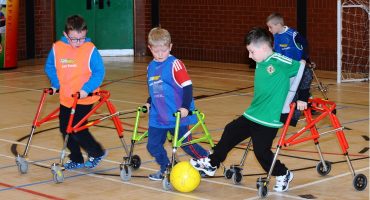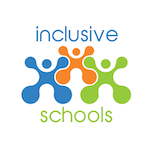
Fairness, inclusion and assessment in [PD]HPE
“Fair isn’t equal; fair is when everyone gets what they need.”
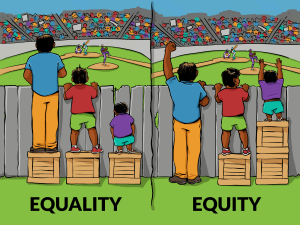
Source: http://interactioninstitute.org/illustrating-equality-vs-equity/
As HPE teachers you have probably seen this image in terms of equality versus equity, but it could also represent the concept of equality versus fairness.
- Equality means giving each person the exact same thing.
- Fairness / Equity means that each person gets what he or she needs to be successful.
Imagine the following scenario in a [PD]HPE class:
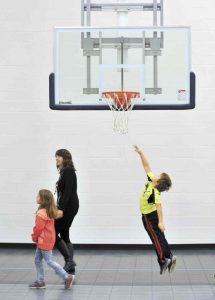
- You have set up a vertical jump test where a braid is hanging from a basketball hoop, so high that only the tallest student can reach it.
- You challenge the students with a reward for whoever can reach the braid.
- When you ask for volunteers to try to reach the braid you choose your tallest student, Lisa who is able to reach the braid and gets a reward.
- When you ask for a second volunteer, you select the shortest person in the class, David.
- After a few unsuccessful attempts, David goes for a chair to help him reach the braid.
- At this point you say, “You can’t use a chair; that would be unfair. Lisa did it without any support. You must do the same.”
- The class starts complaining saying “That’s not fair! David can’t help that he’s short.”
I think most of us would agree with the students here that indeed this scenario is not fair on David (or any of the other students in the class for that matter) as without additional support they will never be able to successfully reach the braid. However, if we allow other students some additional support, they will more than likely be able to demonstrate that they can reach the braid.
The thinking should be no different when we are pondering our assessment processes – but it often is. I regularly have teachers remark that “It’s not fair to the others if I let a student with special needs do an adjusted, scaffolded or different task.” This remark defines fairness as meaning that everyone gets the same (just like the image on the left hand side above) and reflects an attitude of equality rather than equity and fairness.
But what if some students haven’t yet grasped the concepts covered by the assessment? Is it unfair to provide them with more explicit instruction so that they do grasp what is being asked of them? And if a student excels, shouldn’t that student have the opportunity to move on and be extended in their learning?
Meeting each student where they are currently functioning is never unfair to other students.
Continual reminders that students are failing to meet high standards are less effective than establishing where exactly individuals are in their learning, tailoring teaching to meet students at their points of need, and monitoring and celebrating excellent progress towards high standards (Masters, 2014).
“If you aspire to be a world-class high jumper, is it better to set the bar at the world record height and keep attempting to clear it, or to lower the bar to a level you have a chance of clearing and work incrementally up from there?”
Source: Geoff Masters, 2014 Achieving high standards by starting from current performance
Fairness and inclusion
For a classroom, or school to be truly inclusive, it is critical that the difference between fairness and equality are both understood and embraced.
When we determine fairness based on need we help all students to demonstrate what they know, understand and can do – which is the key purpose of assessment in HPE.
The ALL-MOST-FEW framework
The ALL-MOST-FEW framework can be used as a mental template to plan assessment for the learning needs of all students in your classes. The ALL-MOST-FEW framework allows you to plan for degrees of learning rather than planning for 31 individual students.
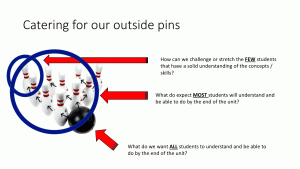
The ALL-MOST-FEW framework allows you to think about how you will prioritise what you will teach, how you will teach it and where the different entry points could be for a class of students with different needs, interests and abilities.
The base represents the learning that you want all students to be able to demonstrate. These are your non-negotiable goal/s. What understanding and skills do all students need to acquire from this unit of work in order to live healthy, safe and active lives (the stated aim of the [PD]HPE curriculum)?
By identifying the key concepts, understandings and skills that are most important for all students to learn you can then identify the teaching strategies and supports required to help them demonstrate this learning. The ALL goal provides the foundation for more complex goals to be built upon. The concepts at this level are not limited to being basic ; the teacher may also identify higher order concepts that are essential for all to learn.
The second level describes additional learning that is an extension of the ALL goal. These are the learning goals that you expect MOST STUDENTS to be able to demonstrate but there may be some in the class that don’t quite get there … and that’s OK.
The third and final layer in the framework describes the most complex concepts and offers the most challenge to the students who need it.
It is common to have multiple levels of readiness, ability and knowledge in a class and for each student this may vary from one area of learning/unit to another. It is therefore important to remember that students’ should not be locked into one level (e.g. a student with a learning difficulty or physical disability), but have access to information from all three parts.
By changing our aim and identifying the supports that all students will benefit from to achieve our non-negotiable (ALL) goals we can add complexity to concepts rather than trying to simplify concepts as we go. It is a more strengths-based model of planning. By planning in layers we are allowing all students, regardless of ability, access to the same curriculum content. Using layers to develop our learning and assessment goals will provide students with more flexibility in how they can demonstrate what they know, understand and can do in relation to that content.
So when you are planning your assessment processes think about what supports will benefit all students to demonstrate exactly what they know, understand and are able to do and plan within your units to include access to these supports for all students in your class. They will be extremely useful for everyone of your students in allowing them multiple ways to demonstrate their learning.
What supports do you use to help all of your students achieving the learning goals?


